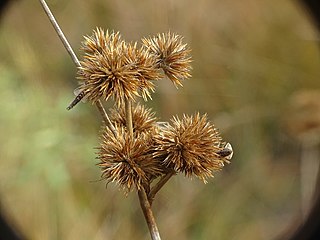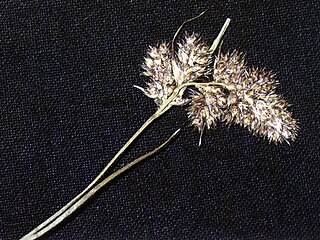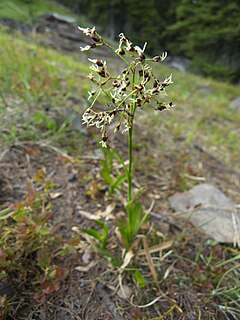
Hydrocotyle vulgaris, also known as marsh pennywort, common pennywort, water naval, money plant, lucky plant or copper coin, is a small creeping perennial aquatic herb native to N. Africa, Europe, the Caucasus and parts of the Levant.
Ivesia muirii is a species of flowering plant in the rose family known by the common name granite mousetail. It is endemic to the High Sierra Nevada of California, where it grows on rocky slopes and cliffs.

Juncus mertensianus is a species of rush known by the common name Mertens' rush or Alaska rush. It is native to much of western North America from Alaska to Saskatchewan to New Mexico, where it grows in wet mountainous areas such as riverbanks and alpine meadows. This is a clumping perennial herb growing from a vertical rhizome. Its smooth, flat stems grow to a maximum height near 40 centimeters. Its few leaves are located at the base and also along the stem. The inflorescence is made up of usually one cluster of many flowers. Each flower has shiny dark brown to black tepals 3 to 4 millimeters long, six stamens with yellowish anthers, and long reddish stigmas, as in image at left. The fruit is a dark, oblong capsule, as in image at right.

Juncus torreyi is a species of rush known by the common name Torrey's rush. It is native to North America, where it is widespread. It can be found in many habitats across the southern half of Canada, coast to coast in the United States, and throughout northern Mexico. This is a perennial herb growing from rhizomes with associated tiny tubers. The smooth stems vary in maximum height from 30 centimeters to around a meter. The leaves are green to pink or red and up to 30 centimeters long. The inflorescences have many dense, rounded clusters of up to 100 flowers each. The flower has narrow, pointed greenish, tan, or reddish tepals and six stamens. The fruit is a pointed brown capsule.
Senecio mattirolii is a perennial herb of the family Asteraceae endemic to altitudes between 3600–4500 meters on the slopes of the mountains of the Ruwenzori Mountains in Uganda and the Democratic Republic of the Congo and an atypical species of the genus Senecio because it has purple flowers.

Astragalus inversus is a species of milkvetch known by the common name Susanville milkvetch.

Clarkia exilis is a small herbaceous annual plant of western North America. It is an uncommon species in the evening primrose family known by the common names Kern River clarkia and slender clarkia.

Eriogonum eremicola is a rare species of wild buckwheat known by the common names Telescope Peak buckwheat and Wild Rose Canyon buckwheat. It is endemic to Inyo County, California, where it is known from only a few occurrences in the Inyo Mountains and Telescope Peak in Death Valley. It grows in sandy to rocky habitat in the forests and woodlands of these desert mountains. It is an annual herb producing a spreading, glandular, reddish green stem up to about 25 centimeters tall. The rounded, woolly leaves are up to about 2.5 centimeters long and are located at the base of the stem. The scattered inflorescences are small clusters of tiny flowers which are white with reddish stripes, aging to solid red, or sometimes yellow. The plant is under protection in Death Valley National Park.
Juncus bryoides is a species of rush known by the common names moss rush and mosslike dwarf rush. It is native to western North America from Oregon to Baja California, where it grows in many types of wet, sandy habitat. It is a very tiny annual herb producing erect, hair-thin stems no more than about 2 centimeters tall. Atop the stem is one flower made up of a few reddish segments 1 to 3 millimeters long which curve around the developing fruit.
Juncus kelloggii is a species of rush known by the common name Kellogg's dwarf rush.
Juncus uncialis is a species of rush known by the common names twelfth rush and inch-high rush. It is native to the western United States, where it is known from wet habitat such as vernal pools. This is a petite annual herb forming dense clumps of hair-thin green stems no more than 3 or 4 centimeters high. The inflorescence is made up of a single tiny flower atop each stem. The flower has several reddish segments about 2 to 5 millimeters long wrapped around the developing fruit.

Leptosiphon ciliatus is a species of flowering plant in the phlox family known by the common name whiskerbrush.
Luzula orestera, with the common name Sierra woodrush, is a species of flowering plant in the rush family. It is endemic to the High Sierra Nevada of California, where it grows in fellfields, talus, and other habitat in regions of subalpine and alpine climates.

Luzula spicata is a species of flowering plant in the rush family known by the common name spiked woodrush. It has a circumpolar distribution, occurring throughout the northern Northern Hemisphere in Europe, Asia, and North America. It grows in subalpine and alpine climates. It occurs at low elevations in colder regions, such as tundra; farther south it is restricted mainly to high mountains. It is a perennial herb forming grasslike clumps of several erect, reddish stems up to about 33 centimeters in maximum height. The stem is thick and its base is buried several centimeters in the soil where it attaches to the roots. The inflorescence is an array of several clusters of brown bristle-tipped flowers. The surrounding bracts and the sheaths surrounding the leaf bases are lined with hairs.
Pyrrocoma carthamoides is a species of flowering plant in the aster family known by the common name largeflower goldenweed. It is native to western North America from British Columbia to northeastern California to Wyoming, where it is known from grassland, woodlands, forests, barren areas, and other habitat. It is a perennial herb growing from a taproot and producing one or more stems to about half a meter in maximum length, the stems reddish-green and leafy. The largest leaves are at the base of the stem, measuring up to 20 centimeters long, lance-shaped with spiny sawtoothed edges. Leaves higher on the stem are smaller and hairier. The inflorescence is a single flower head or a cluster of up to four. Each bell-shaped head is lined with phyllaries each up to 2 centimeters long. It has many yellow disc florets surrounded by a fringe of yellow ray florets up to 7 millimeters long; ray florets are occasionally absent. The fruit is an achene which may be well over a centimeter in length including its pappus.

Pyrrocoma lanceolata is a species of flowering plant in the aster family known by the common name lanceleaf goldenweed. It is native to western North America from central Canada to northeastern California to Colorado, where it grows in many types of habitat, including disturbed places and areas with wet, alkali soils. It is a widespread and variable plant. It is a perennial herb growing one or more stems up to about half a meter long. The stems are decumbent or upright, reddish, usually somewhat hairy to quite woolly, and glandular toward the ends of the stems. The largest leaves are at the base of the plant, each measuring up to 30 centimeters in maximum length. They are generally lance-shaped with sawtoothed edges. The inflorescence bears several, up to 50, flower heads lined with reddish to green phyllaries. Each contains yellow disc florets and ray florets. The fruit is an achene up to a centimeter long including its pappus.
Packera subnuda is a species of flowering plant in the aster family known by the common names Buek's groundsel and cleftleaf groundsel. It is native to western North America from the Northwest Territories to northern California to Wyoming, where it grows in high mountain meadows in subalpine and alpine climates.
Streptanthus oliganthus is an uncommon species of flowering plant in the mustard family known by the common name Masonic Mountain jewelflower. It is native to western Nevada and eastern California, where it grows in the rocky hills east of the central Sierra Nevada. Its habitat includes forest, woodland, sagebrush, and mountain talus. It is a rhizomatous perennial herb producing a hairless, waxy, usually unbranched stem up to about 40 or 50 centimeters in maximum height. The basal leaves have lance-shaped, smooth-edged blades up to 10 centimeters long borne on fuzzy to rough-haired petioles. Leaves higher on the stem have shorter blades which may clasp the stem at their bases. Flowers occur at intervals along the upper stem. Each has a bell-shaped calyx of purple sepals no more than a centimeter long. The petals emerging from the tip are reddish purple or purple-tipped. The fruit is a smooth, flat, straight or slightly curved silique up to 8 to 10 centimeters long.
Juncus digitatus is a rare species of rush known by the common name finger rush. It is endemic to Shasta County, California, where it is known from only two occurrences near Shingletown. It occurs in spring-moist habitat such as vernal pools in sunny locations in the foothills of the southernmost Cascade Range. The plant was first collected in 1991 and described to science as a new species in 2008.

Luzula hitchcockii is a species of flowering plant in the rush family known by the common names smooth woodrush and Hitchcock's wood rush. It is native to western North America from British Columbia and Alberta to Oregon to Wyoming. It is sometimes treated as a variety of Luzula glabrata.









